Don't wanna be here? Send us removal request.
Text
Undergraduate Programmes
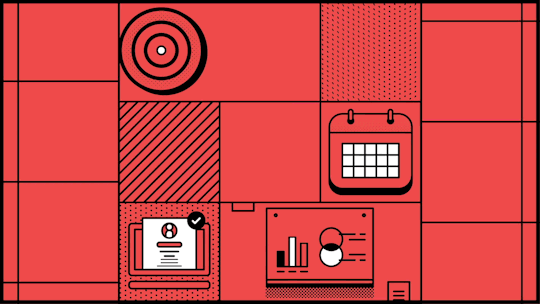
https://www.singaporetech.edu.sg/undergraduate-programmes
0 notes
Text
Driving the future of autonomous mobility

SIT developed its first Electric Autonomous Vehicle as a key learning tool for Telematics undergraduates
True to SIT’s status as Singapore’s university of applied learning, an electric autonomous vehicle (EAV) has been deployed for the primary purpose of bringing the technology up close and personal to students reading the Bachelor of Engineering with Honours in Telematics (Intelligent Transportation Systems Engineering) programme.
Aptly named as The S.E.A.D. Car, which stands for The SIT Electric Autonomous Driving Car, it has started making its rounds on SIT@Dover campus grounds, much to the delight of the SIT community.
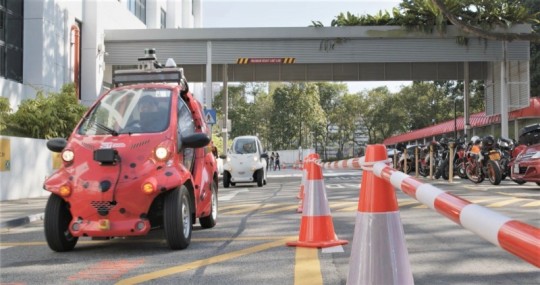
PHOTO: The S.E.A.D. Car is set to be a mainstay at SIT@Dover
Developed in close partnership with SIT industry partner SingPilot, The S.E.A.D. Car consists of input by SITizens through their Integrated Work Study Programme (IWSP) with the company. Year 3 students Boris Khoo and Alvin Lim Jing Yik had the opportunity to contribute to the development of the vehicle by creating a modular design for the EAV’s vehicular controls, including functions such as the acceleration, brakes and gear system, among others.
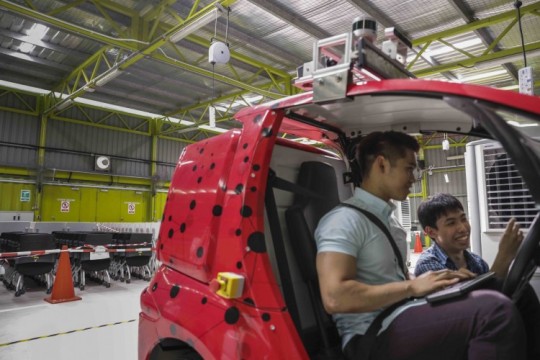
PHOTO: Students getting up close and personal with the EAV to learn about autonomous technology
The EAV enhances students' laboratory experience to build capabilities in the autonomous domain. It is also a prime example of how students can 'get their hands dirty' with technology that is relevant to modules focused on location sensors, inter-car connectivity and other intelligent automotive systems-related subjects.
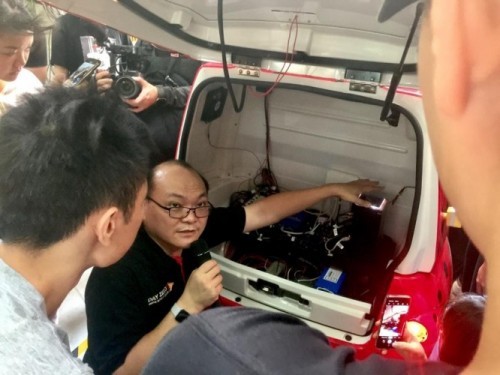
PHOTO: Mr Dan Chia, Senior Lecturer, SIT, taking students through the EAV's various functions in detail
"The future of mobility rests in the development of smart technology of today. At SIT, we are driven to pave the way forward together with our students, the innovators of tomorrow. The S.E.A.D. Car represents our commitment to exploring the potential in transforming our transport system in smart nation Singapore," said Associate Professor Zheng Jianxin, Programme Director, BEng (Hons) in Telematics (ITS Engineering).
Acting as a test bed for a complete smart transportation network, the EAV will also complement the installation of Smart Lamp Posts around the campus, driving research on the communication between autonomous vehicles and infrastructure. These lamp posts can be used to direct driverless cars, catch speeding e-scooters and even analyse faces, down to race, gender and age.
Successful runs of the EAV will ascertain deployment of more EAVs in the future SIT@Punggol campus.
0 notes
Text
Championing Applied Learning
As our economy continues to transform, the role of applied learning in higher education has grown in significance. Since 2014, as Singapore’s university of applied learning, the Singapore Institute of Technology (SIT) has grown from strength to strength in nurturing an industry-ready workforce to drive Singapore’s future growth.
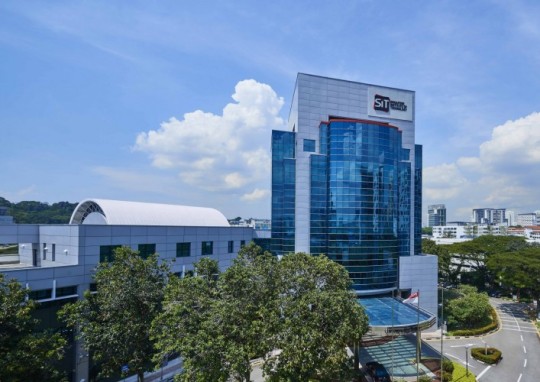
Pioneering applied learning
A pioneer in applied learning, SIT was set up in 2009 to provide an upgrading pathway for deserving polytechnic graduates to obtain industry-relevant degrees. From an inaugural batch of 500 students, SIT has grown to be a full-fledged Autonomous University with 7,000 students, offering 42 degree programmes, including 14 of its own and 15 jointly with renowned overseas universities.
Its growth is backed by a distinctive commitment to engage students in innovative pedagogy by integrating learning, industry and community; and focusing on offering applied degree programmes that cater to diverse student profiles and industry needs.
SIT is unique in its applied learning pedagogy. With more than 90 per cent of its undergraduates from polytechnics, SIT has a student population of handson learners. SIT elevates their learning experience by instilling in them a mindset of learning by doing, rather than learning for doing, to enhance their industry-readiness.
At SIT, applied learning is weaved into every aspect of a student’s learning journey, whether it is in the classroom or the real world and whether it is during learning or assessments. Its unique pedagogy of integrating work and study is built upon a solid foundation of industry collaborations and an expanding line-up of programmes catering to emerging economic sectors.
Unlike other universities, SIT has organised its academic staff according to technical domain clusters instead of faculties. This matrix academic structure has stimulated interdisciplinary collaborations and teaching across related disciplines.
Industry-centric education
SIT carries its applied learning approach fully through its curriculum, to create a seamless work-study and highly industry-focused educational journey for its students. The university boasts close collaboration with various industry partners that opens up to its students abundant opportunities for industry attachments and work-study programmes.
In addition, SIT has also established Industry Advisory Committees (IAC), comprising key industry leaders, to guide the curricula development of its degree programmes. Their feedback allows SIT to continually shape its curricula to ensure its industry relevance.
Industry knowledge is delivered to students every day at SIT, as the majority of its faculty staff are also part-time consultants in their respective industries. Their industry experience and professional networks entrench a long-lasting industry and academia collaborative relationship that translates to an authentic learning environment for students.
SIT takes its industry focus further with its corps of Professional Officers. Drawing on their profound industry experience, these individuals mentor students undertaking industry attachments and projects, guiding and motivating them to maximise every learning opportunity.
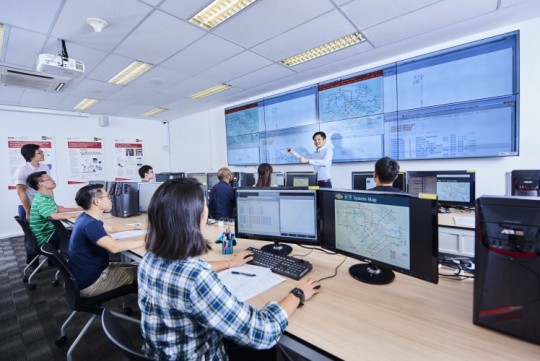
PHOTO: Students are exposed to specialised modules such as railway simulation as part of their learning
Integrated Work Study Programme
Demand for SIT graduates is seen in its overall graduate employment rate that reached 92.3 per cent in 2017. A key driver of this positive outcome is the Integrated Work Study Programme (IWSP), a compulsory component for students in SIT-conferred and joint degree programmes.
In IWSP, students spend eight to 12 months working and studying. The extended period enables students to participate in projects with longer timeframe and make significant contributions to the company.
IWSP gives SIT students a firm head start to the working world, by exposing them to the latest industry developments, business intricacies and work cultures. The work-study continuum also helps undergraduates transit to their future jobs with lesser effort and greater success.
For example, students of the Sustainable Infrastructure Engineering (Land), or SIE (Land), degree programme have gained deep insights into Singapore’s land transport development, through IWSP at organisations such as the Land Transport Authority, SMRT and SBS Transit.
To date, more than 1,300 students from 16 programmes have completed IWSP at more than 500 companies. However, to the industry, IWSP is more than just an attachment programme – it has become a conduit to identify and recruit future talents.
In a preliminary survey of the Class of 2018 conducted by SIT, close to 70 per cent of graduates from SIT-conferred degrees received employment offers from firms where they did their IWSP, and over 90 per cent among those surveyed had secured jobs. In particular, for the SIT Accountancy programme, 92 per cent of the cohort received advance job offers upon completion of their IWSP.
These results attest to the effectiveness of SIT’s approach in enhancing its students’ employability by emphasising on real industry assignments in IWSP.
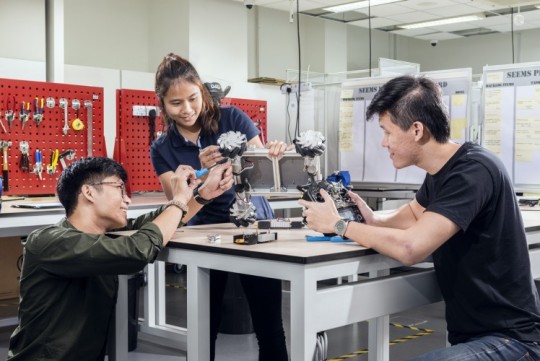
PHOTO: At SIT, students’ learning is reinforced through doing and hands-on practice.
Diverse engineering programmes
SIT offers diverse, multi-disciplinary engineering degree programmes that are closely aligned with Singapore’s key economic growth sectors. These include aerospace, chemical, civil, electrical power, marine, mechanical, land transport, pharmaceutical, systems and software engineering.
Its curriculum trains students to be professionals with a mastery of deep specialist skills in their chosen disciplines. This creates a distinctive edge to the students’ professional competencies, while building a strong pipeline of specialist engineers to solve increasingly complex industry problems.
Thus far, SIT has introduced several first-of-its-kind specialised degree programmes in Singapore. Launched in 2014, the SIE (Land) programme focuses on nurturing talents to meet latest demands in railway engineering and has already graduated its pioneer cohort of BEng and MEng students in October 2018.
SIT also introduced the Telematics (Intelligent Transportation Systems Engineering) programme in 2016, in view of the rising impact of telematics in the automotive, avionics and marine industries. This unique programme gears students towards supporting the growth of transportation super-infrastructure in Singapore.
In 2018, SIT unveiled the Aircraft Systems Engineering programme in collaboration with SIA Engineering Company. Built on an interdisciplinary curriculum that intersects engineering, science and a hands-on approach, the focus of the programme is to produce graduates for the aerospace and MRO industries.
All in all, while still studying at SIT, students would have gained a firm footing in the workplace and more importantly, made a big step towards becoming catalysts of Singapore’s future transformation.
This article was adapted from The Singapore Engineers April 2019 publication with the permission of The Institution of Engineers, Singapore.
0 notes
Text
A lean way to address industry problems

As part of SIT’s applied learning pedagogy, 160 students from SIT’s Sustainable Infrastructure Engineering (SIE) (Land) degree programme have embarked on 30 lean projects with 16 host companies since 2016 to help improve productivity and work processes.
This mutually beneficial endeavor was initiated by SIT faculty, Associate Professor Mustafa Shabbir Kurbanhusen, as part of the ‘Lean and Quick Response Repair’ module in the SIE (Land) programme.
The first six weeks in the learning journey are focused at equipping students with knowledge on the lean principles and tools to eliminate the ‘8 wastes’ commonly found in any process. This is reinforced through activity-based workshops to apply the lean concepts. The remaining six weeks will see the students working on ‘real’ industry problems. Companies are engaged as industry hosts to the students to work on lean-based productivity enhancement problem statements. These companies are from various sectors including government agencies, healthcare, transport, engineering, real estate and food manufacturing.
Students have to regularly visit the companies on-site to obtain crucial information for continual improvement opportunities. This is in tandem with weekly consultation with SIT faculty and professional officers to address industry challenges and come up with implementable solutions. Deliverables include a report, poster and presentation to the industry host detailing the ‘value stream map’ – a visual map showing the current process – as well as the proposed recommendations for follow-up.

PHOTO: Activity-based workshops to equip students with lean knowledge, coupled with hands-on application.
Improving Processes at Old Age Home
Lee Ah Mooi Old Age Home is one of the pioneer organisations who came on board this initiative. It engaged the help of SIT students to look into improving its processes, including the adult diaper storage and retrieval system, as well as the laundry retrieval, sorting and storage process. The teams from SIT were able to identify the wastes in the processes and recommend feasible solutions, such as implementing gravity flow rack, diaper dispensing bins, and storage boxes with dividers for laundry.
“Throughout the course of the project, we achieved key milestones such as increased efficiency in store and inventory management of essential medical consumables. With the experience gained, we are able to better manage and improve workflows. Furthermore, the sense of satisfaction upon fulfilling the module is tremendous and applicable to future work,” shared Veronica Chng, SIE (Land) student.
“We appreciate the help of SIT students in executing these projects, which may be trivial but beneficial for us. The walkthrough of our processes gave us an opportunity to rethink them and the students’ inputs have helped us in making some minor changes and streamlining our work too. The changes will ultimately benefit our residents greatly,” said Mr Then Kim Yuan from Lee Ah Mooi Old Age Home.
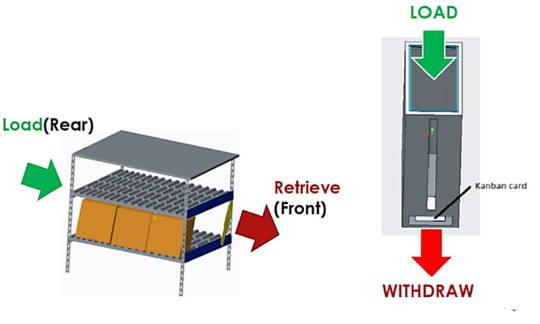
PHOTO: Some recommendations for Lee Ah Mooi Old Age Home included the use of gravity flow rack and diaper dispensing system to improve the work flow.
Enhancing Deployment of Mobile Dental Clinics
Another team of SIT students took on the task to review and streamline the deployment of mobile dental clinics for Unity Denticare. After an extensive analysis of the current work process, the team came up with a standard operating procedure (SOP) document to ensure clients are aware of their respective roles. To ensure a seamless flow of patients, the students also designed banners and signage to encourage walk-ins from the public.
“It is good that the students are encouraged to go to the ground to observe and ask questions. Kudos to the students for being patient and proactive to get to the root of the problem,” remarked Mr Jonathan Tan from Unity Denticare.
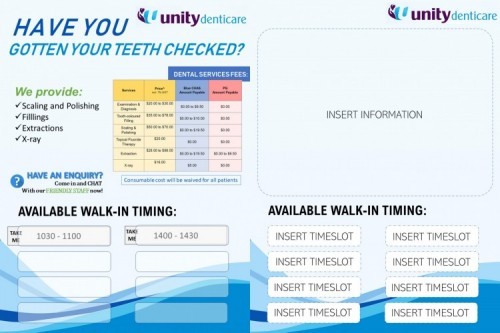
PHOTO: The banner designed by the students to encourage walks-ins from the public.
Improving Customer Engagement
COMAT, a training services centre under ST Electronics, was keen to enhance its customers’ experience. The SIT team focused on tackling issues such as long queues during peak period, manual registration process, and difficulties in finding training rooms. The team came up with a detailed wayfinding guide, including visual map, floor and wall markings to direct customers to the correct training location. In addition, the team also designed a self-directory information display for the TV screens, which had received positive feedback from the users.
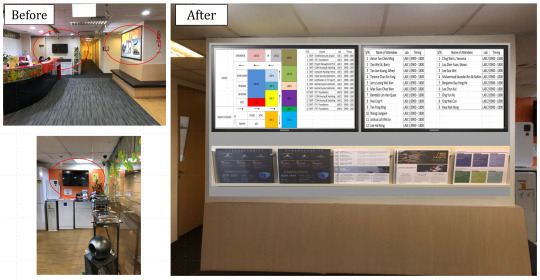
PHOTO: One recommendation from the students was to display clear, colour-coded course information on the TV screens.
“The programme provided us an independent perspective on our current processes. In addition, the students proposed several areas of improvement in which we could look into to improve our customer engagement and experiences,” commented Mr Alton Loo from ST Electronics (e-Services).
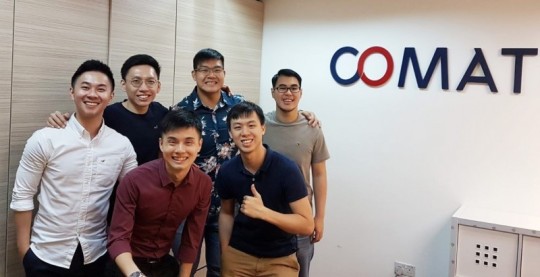
PHOTO: The SIT team with Mr Alton Loo (in red).
For the students, the lean module provides them with industry exposure before they go out for their one-year Integrated Work Study Programme (IWSP). They can then proactively apply the lean knowledge learnt to initiate productivity enhancement projects in their IWSP organisations, reinforcing SIT’s mission to produce industry-ready graduates.
Alfred Tan, SIE (Land) student who completed the project with COMAT, remarked, “Through this project opportunity, our team took back many valuable lessons on how lean can be applied to enhance the service standards of a company. For example, the ‘Gemba Walk’ concept allows us to gain a deeper understanding of the company through interactions with full-time staff.”
Another student, Shaun Lau, commented, "Performing Lean for Unity Denticare has allowed me to work closely with the industry to provide more value for my clients, while benefiting the community. Improvements in turnout rates of dental patients and operational procedures are examples of key milestones achieved. This experience has translated to benefit my IWSP organisation – SYSTRA, through enhancement of various processes such as the creation and implementation of a new quality management system and efficient client facing."
0 notes
Text
Grooming Industries’ Finest
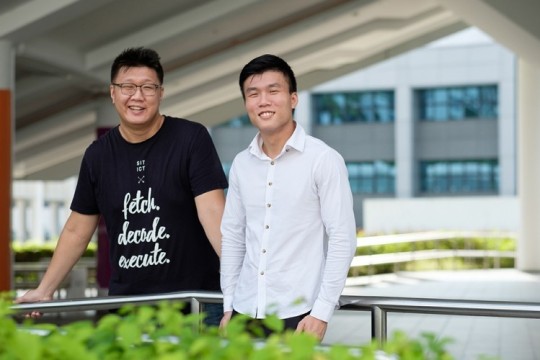
The mission of Singapore Institute of Technology (SIT) have been clear right from the start: to groom and develop future-ready leaders who are well-trained in industry knowledge and highly demanded by employers. To achieve these, SIT centres its curriculum on technical knowledge and applied learning. Its flagship Integrated Work Study Programme (IWSP) requires all SIT undergraduates to immerse themselves fully in the industry for eight to 12 months to gain a full perspective of their fields of expertise before stepping foot into the corporate world.
Ang Guo Gen and Lim Xing Yi, recent graduates with a Bachelor of Engineering with Honours in Information and Communications Technology, have these to say of their education at SIT, and the secured future they are about to embark on.
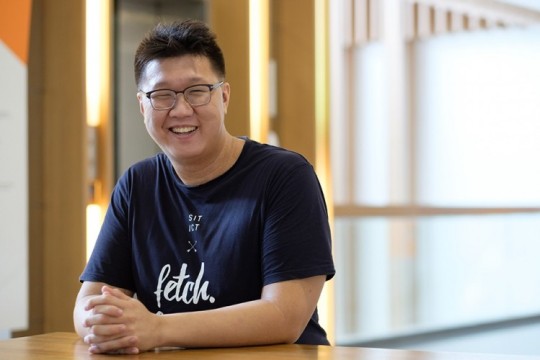
PHOTO: Ang Guo Gen, Systems Engineer, Cyber Security Agency Singapore. Bachelor of Engineering with Honours in Information and Communications Technology (Information Security).
I chose SIT for the Integrated Work Study Programme.
"As an information security consultant at Wizlynx Group during my IWSP, I was tasked with performing various assessments and solving industry problems for customers worldwide. These included mobile and web application penetration testings, network vulnerability assessment, and data security configuration review.
I worked with colleagues from Mexico, China, and Switzerland as Wizlynx Group is an international company with offices all around the globe. I was also given the opportunity to take part in an industry-level Capture-The-Flag competition with my IWSP supervisor where I learned different strategies in attacking, defending, and solving tasks.
The greatest takeaway from my IWSP would be the skills, professional work ethics, and network connections gained during the period. It equipped me with the understanding of how the industry worked and how I could contribute to it, based on the theoretical and practical skillsets I learned at SIT.”
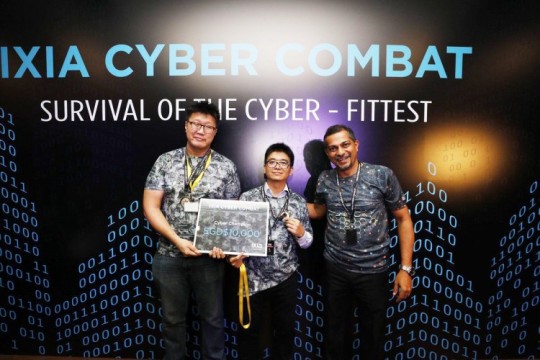
PHOTO: Ixia Cyber Combat 2017 – Champion (1st from left)
SIT transitioned me into a highlyspecialised professional with deep technical expertise.
“Throughout the pursuit of my degree, I have participated in many competitions to hone my information security technical skills and knowledge. It allowed me to further improve my learning by performing research and conducting studies to master the unsolved challenges after the competitions.
I am now working as a systems engineer performing pentesting and security assessments at the Cyber Security Agency of Singapore, the national agency overseeing cybersecurity strategy and operation, education, outreach and ecosystem development, which is part of the Prime Minister’s Office and managed by the Ministry of Communications and Information. As SIT’s education is practice oriented and industry-focused, I believe I am well-equipped to excel in my role and contribute back to society, which was the reason I got into the information and communications technology industry in the first place.
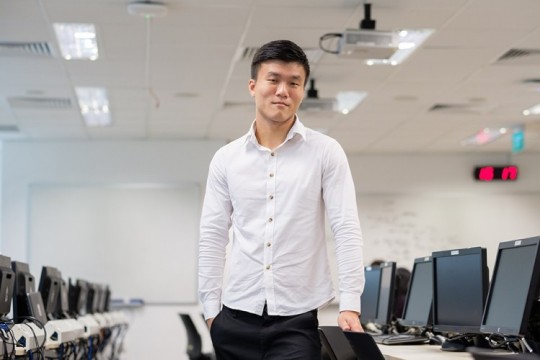
PHOTO: Lim Xing Yi, Digital Business Technologist, StarHub Ltd. Bachelor of Engineering with Honours in Information and Communications Technology (Software Engineering)
One of the unique features of my degree programmes is that the capstone project is set by the company during the IWSP. I find this approach meaningful and valuable.
“I did not implement a project simply for grading purposes, but served it as a real-world project for LDR Pte Ltd, where I was attached to for my IWSP. As a mobile app developer, I applied the knowledge I had gained at SIT, such as conducting usability test for user experience, and secure coding methodology by performing source code analysis. Besides that, I had picked up new programming languages, such as Swift 3, and extended my knowledge in one of the NoSQL databases, such as MongoDB.
The IWSP is a good platform for undergraduates to further explore their own interests and assess their capabilities, in terms of the type of industry and job scope that suits them before stepping out into the workforce.”
SIT’s applied learning pedagogy defintely trains and prepares graduates like me to be industry-ready. I am honoured to have won the Singapore Valley Award 2018 and earned a three-month internship with internet company 2345.com in China.
“I gained first-hand insight into the huge mobile app market in China and how the cashless society operates. As an assistant web software engineer, I have learned from my manager at 2345.com on how to be flexible and adaptable to changes to support increasing demand during peak periods.
Although I had prior working experience, SIT’s holistic curriculum allowed me to learn various software engineering practices that I was not previously exposed to in my previous employment. For example, we not only covered platforms that can be programmed, but also areas such as user experience, software performance, security, and project management which are essential to building quality software. The applied knowledge and invaluable soft skills that I learned at SIT have undoubtedly enriched my experience and deepened my technical skillsets, as I begin my career at StarHub.”
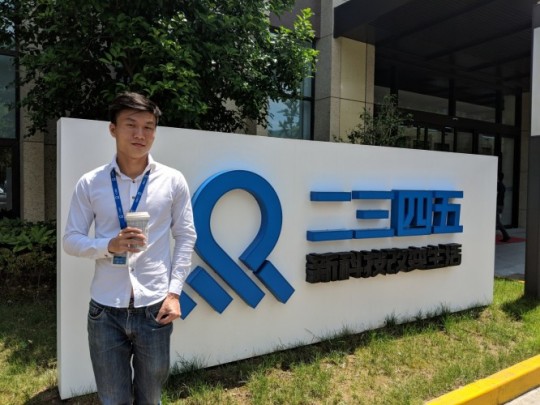
PHOTO: Internship at 2345.com in China
This article was adapted from the BrightMinds 2018: Polytechnic and University Edition with the permission of CareerBuilder Singapore.
0 notes